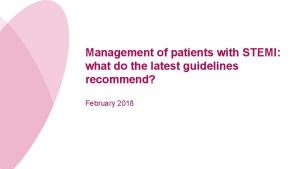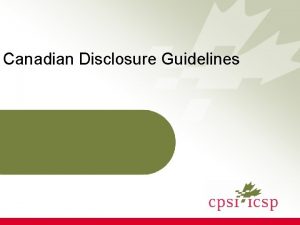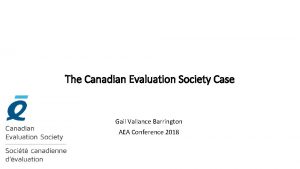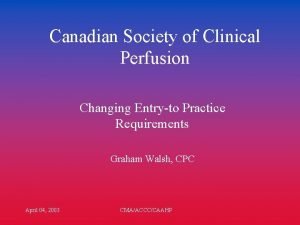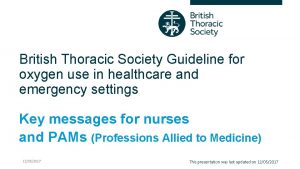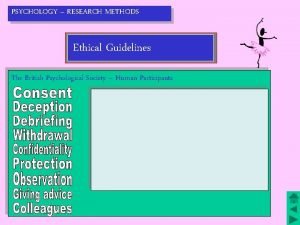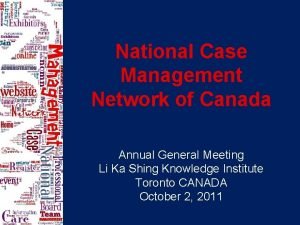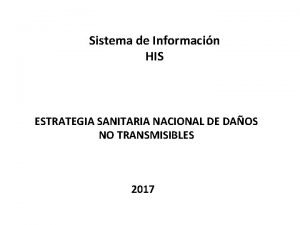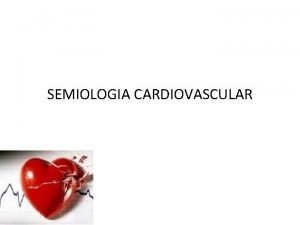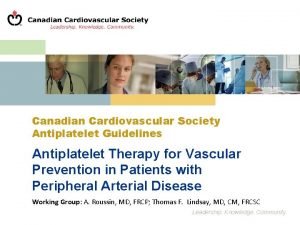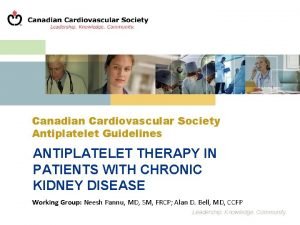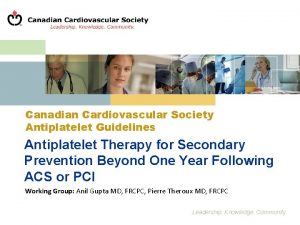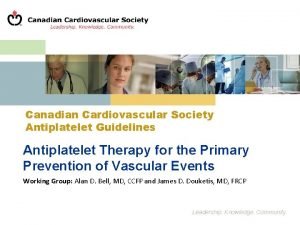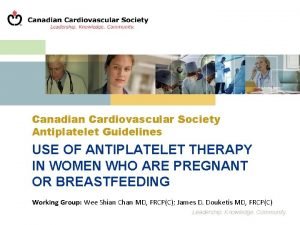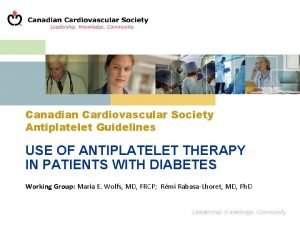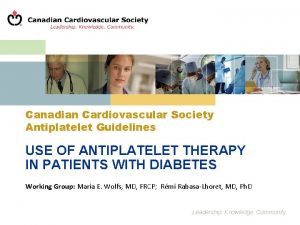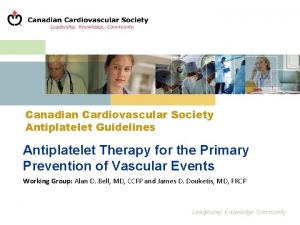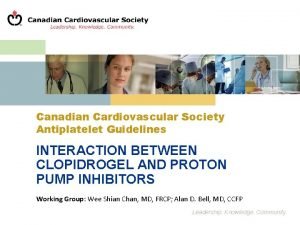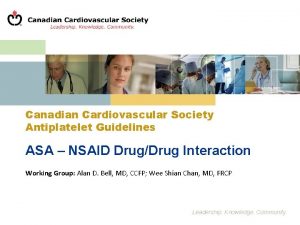Canadian Cardiovascular Society Antiplatelet Guidelines MANAGEMENT OF ANTIPLATELET















- Slides: 15

Canadian Cardiovascular Society Antiplatelet Guidelines MANAGEMENT OF ANTIPLATELET THERAPY IN ASSOCIATION WITH MINOR BLEEDING Working Group: James D. Douketis MD, FRCP(C); A. Graham Turpie MD, FRCP(C) Leadership. Knowledge. Community.

Objectives Interpret the Canadian Cardiovascular Society Guideline recommendations regarding the use of antiplatelet therapy in patients presenting with minor bleeding events. Appropriately investigate patients on antiplatelet therapy with minor bleeding events. © 2011 - TIGC

Case study no. 1 68 year old woman with cerebrovascular disease and new polymyalgia rheumatica presents with ecchymoses over arms and legs. Receiving ASA, 325 mg daily; other drugs include: Prednisone, 5 mg daily Periodic over-the-counter NSAID Other cardiovascular risk factors: Prior stroke Hypertension Type 2 diabetes © 2011 - TIGC

Management question A. Stop ASA. B. Continue ASA at 325 mg daily. C. Continue ASA but decrease dose to 81 mg daily. D. Taper and stop prednisone. E. Taper and stop prednisone and reduce ASA to 81 mg daily. © 2011 - TIGC

Evidence Minor bleeding during antiplatelet therapy Studies assessing incidence, consequence and management of antiplatelet drug-associated minor bleeding are lacking. Minor bleeding is usually self-limiting. Ecchymoses and petechiae Petechiae (pinpoint capillary-based hemorrhage) typically occur in ASA- or clopidogrel-treated patients who have thrombocytopenia (platelet count usually <50 × 109/L). Ecchymosis (subcutaneous venous bleeding) can occur in ASAand clopidogrel-treated patients who are receiving warfarin or corticosteroids or with a superimposed coagulopathy. © 2011 - TIGC

Petechiae and Purpura

® Recommendations Patients who are receiving ASA (or ASA + clopidogrel) and develop ecchymosis and/or petechiae should undergo testing with a CBC, INR and a. PTT to investigate for thrombocytopenia or a coagulopathy (Class IIa, Level C). In the absence of superimposed abnormalities in hemostatic function, antiplatelet drugs can be continued with clinical observation, whereas in patients with thrombocytopenia or a coagulopathy, ASA (or clopidogrel) should be stopped pending further investigations (Class IIa, Level C). 7

What if? The prednisone is stopped but painful hip girdle symptoms recur from PMR. Patient is put back on prednisone. What to do with ASA? © 2011 - TIGC

Case study no. 2 65 year old man with CAD and prior NSTEMI/PCI 2 years ago Presents with ‘red eye’ Recent cold symptoms No eye discharge or pain, no recent head injury Receiving ASA, 81 mg and clopidogrel, 75 mg No treatment with NSAIDs Blood tests Platelets = 250 × 109/L, INR = 1. 2, a. PTT = 36 sec © 2011 - TIGC

Subconjunctival hemorrhage © 2011 - TIGC

Management question A. Stop ASA and clopidogrel until bleeding clears. B. Stop clopidogrel only until bleeding clears. C. Continue both ASA and clopidogrel. D. Stop clopidogrel for 7 -10 days until bleed clears. E. Stop ASA and clopidogrel for 7 -10 days until bleeding clears. © 2011 - TIGC

Evidence Clinical trials and observational studies as to clinical course and prognosis are lacking. Subconjunctival bleeding is more common in anticoagulant-treated than antiplatelet-treated patients. Precipitated by coughing or straining during a bowel movement. Self‑limiting, resolves within 1 -2 weeks, and does not affect visual acuity. © 2011 - TIGC

® Recommendation Patients who are receiving ASA (or ASA + clopidogrel) in whom subconjunctival bleeding develops should continue treatment and be monitored for bleeding (Class IIa, Level C). 13

® Antiplatelet therapy in patients with minor bleeding 14

© 2011 - TIGC
 Fibrinolytic checklist time goal stroke
Fibrinolytic checklist time goal stroke Tavr antiplatelet guidelines
Tavr antiplatelet guidelines Fibronigen
Fibronigen Ccs perioperative guidelines
Ccs perioperative guidelines Canadian disclosure guidelines
Canadian disclosure guidelines Canadian evaluation society
Canadian evaluation society Triple e bottom line
Triple e bottom line Canadian society of clinical perfusion
Canadian society of clinical perfusion Venturi mask uses
Venturi mask uses British psychological society ethical guidelines
British psychological society ethical guidelines Canadian emergency management college
Canadian emergency management college Canadian standards of practice for case management
Canadian standards of practice for case management Gertler econ
Gertler econ Blood vesel
Blood vesel Riesgo cardiovascular por perimetro abdominal
Riesgo cardiovascular por perimetro abdominal Azoulay maniobra
Azoulay maniobra
